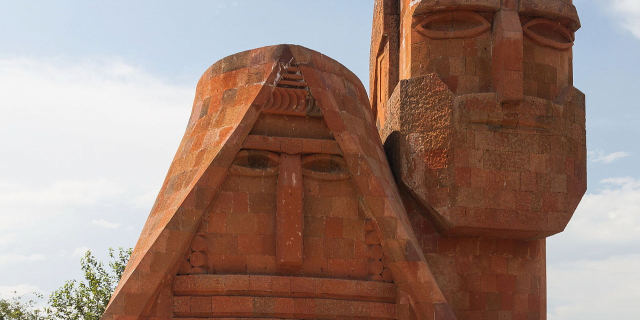The Maiden Tower (Azerbaijani: Qız qalası) is a 12th-century monument in the Old City, Baku, Azerbaijan. Along with the Shirvanshahs' Palace, dated to the 15th century, it forms a group of historic monuments listed in 2001 under the UNESCO World Heritage List of Historical Monuments as cultural property, Category III. It is one of Azerbaijan's most distinctive national emblems, and is thus featured on Azerbaijani currency notes and official letterheads.
The Maiden Tower houses a museum, which presents the story of the historic evolution of Baku city. It also has a gift shop. The view from the roof takes in the alleys and minarets of the Old City, the Baku Boulevard, the house of Isa bek Hajinski and a wide vista of the Baku Bay.
The Tower is covered by cloud of mysteries and legends which are rooted to the history and culture of Azerbaijan. Indeed, some epics became a subject for scenario for ballets and theatre's p...Read more
The Maiden Tower (Azerbaijani: Qız qalası) is a 12th-century monument in the Old City, Baku, Azerbaijan. Along with the Shirvanshahs' Palace, dated to the 15th century, it forms a group of historic monuments listed in 2001 under the UNESCO World Heritage List of Historical Monuments as cultural property, Category III. It is one of Azerbaijan's most distinctive national emblems, and is thus featured on Azerbaijani currency notes and official letterheads.
The Maiden Tower houses a museum, which presents the story of the historic evolution of Baku city. It also has a gift shop. The view from the roof takes in the alleys and minarets of the Old City, the Baku Boulevard, the house of Isa bek Hajinski and a wide vista of the Baku Bay.
The Tower is covered by cloud of mysteries and legends which are rooted to the history and culture of Azerbaijan. Indeed, some epics became a subject for scenario for ballets and theatre's plays. The ballet Maiden Tower is a world-class masterpiece of the Azerbaijani ballet created by composer Afrasiyab Badalbeyli in 1940; a remake of the ballet was performed in 1999.
Consequent to the receding of the sea shoreline of the Caspian Sea, a strip of land emerged. This land was developed between the 9th and 15th centuries, when the walls of the old city, the palace including the huge bastion of the Maiden Tower were built.
Some scientific sources indicate that the Maiden Tower is a paramount example of Zoroastrianism and the pre-Islamic architecture in Iran and Azerbaijan.[1][2] Davud A.Akhundov provides archeological and architectural evidences and argues that the Tower is Zoroastrians' Fire temple-Tower which had 7 fire exits on the top of the tower.[3] Zoroastrian believed that there are 7 Steps or 7 Sky to reach heaven.
Davud A.Akhundov and Hassan Hassanov date the fire temple-tower approximately as 8th-7th century B.C.[4][5][6]
The Maiden Tower set in the south-east part of Icheri Sheher, has mystique and hoary history and legends that are linked to two periods, though not conclusively established. The area was first settled in the Palaeolithic period.[7]
 Depiction of Maiden Tower on a 10 Azerbaijani manat banknote (1993)
Depiction of Maiden Tower on a 10 Azerbaijani manat banknote (1993)Sara Ashurbeyli, Professor and prominent historian and expert in the history of Baku has calculated that the tower foundations, which extend 15 metres below ground level and the bottom three stories above ground, were originally built between the 4th and 6th centuries CE and points out the marked difference in the stone used in the tower compared to the stone used in the medieval city surrounding it.[8] This conclusion is partly supported by historian Bretanitskiy who has postulated that the tower was partly built in the 5th to 6th centuries and then later in the 12th century.[8] The site was believed to have been used originally during the Sasanid era as a Zoroastrian temple.[9] An inscription located 14 metres high on the south wall which in old Kufic script mentions Qubbeye Masud ibn Davud or Kubey Mesud ibn Da’ud, an architect active during the 12th century; he is the father of the architect who built the Mardakan Round Tower.[10] However it is disputed as the inscription, unlike the Mardakan Tower inscription, does not actually reveal him to have been the architect, although it is generally agreed that much of the modern tower dates back to the 12th century.[8] Ahmadov believes that the tower was used as an astronomical observatory from the time of this reconstruction, due to the fact that 30 hewed stone protuberances on the tower's lower section and the 31 protuberances on the upper section, linked with a stone belt, correlate to the days of the month.[8]
According to recent archaeological excavations, carried out in 1962–63 on the ground floor of the tunnel, the tower was built on a large rock sloping toward the sea, and the buttress structure projecting out from the main tower provided stability to the tower. Further excavations have also revealed wooden girders, each 14 metres (46 ft) high, at the foundation of the tower. This has been inferred as an earthquake-resistant design. It has also been conjectured that the cylindrical shape of the tower with 5 metres (16 ft) thick base walls tapering to 4.5 metres (15 ft) (4 metres (13 ft) is also mentioned) provided the solid foundation on which it has survived over the centuries. It is also mentioned that the tower was built at one go and not at different times as inferred by other scholars.[11]
The tower and other wall structures now under the UNESCO list were strengthened during the Russian rule in 1806 and have survived.[12]
The Maiden Tower is depicted on the obverse of the Azerbaijani 1 to 250 manat banknotes of 1992–2006,[13] and of the 10 manat banknote issued since 2006,[14] as well as on the obverse of the Azerbaijani 50 qəpik coin minted between 1992 and 2006[15] and the reverse 5 qəpik coin minted since 2006.[16]



































Add new comment